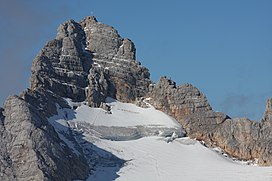Hoher Dachstein
This articleneeds additional citations forverification.(February 2013) |
| Hoher Dachstein | |
|---|---|
 Hoher Dachstein summit | |
| Highest point | |
| Elevation | 2,995 m (9,826 ft)[1] |
| Prominence | 2,136 m (7,008 ft)[1] Ranked 8th in the Alps |
| Listing | Ultra |
| Coordinates | 47°28′31″N13°36′23″E/ 47.47528°N 13.60639°E[1] |
| Naming | |
| English translation | high roof stone |
| Language of name | German |
| Pronunciation | German:[ˌhoː.ɐˈdaxʃtaɪn] |
| Geography | |
| Location | Upper Austria/Styria,Austria |
| Parent range | Northern Limestone Alps |
| Geology | |
| Age of rock | Triassic |
| Mountain type | Limestone |
| Climbing | |
| First ascent | 1834 Peter Karl Thurwieser, Adam und Peter Gappmayr (Gosau side) |
| Part of | Hallstatt-Dachstein /SalzkammergutCultural Landscape |
| Criteria | Cultural: (iii)(iv) |
| Reference | 806 |
| Inscription | 1997 (21stSession) |

Hoher Dachstein(German:[ˈhoːɐˈdaxʃtaɪn]) is a stronglykarsticmountainin centralAustriaand the second-highest mountain in theNorthern Limestone Alps.It is situated at the border ofUpper AustriaandStyria,and is the highest point in each of those states. Parts of the massif also lie in the state ofSalzburg,leading to the mountain being referred to as theDrei-Länder-Berg( "three-state mountain" ).
The Dachstein massif covers an area of around 600 square kilometres (230 sq mi) with dozens of peaks above 2,500 m, the highest of which are in the southern and southwestern areas. The main summit of the Hoher Dachstein is at an elevation of 2,995 metres (9,826 ft). Seen from the north, the Dachstein massif is dominated byglacierswith rocky summits rising beyond them. By contrast, to the south, the mountain drops almost vertically to the valley floor.
Geology
[edit]Thegeologyof the Dachstein massif is dominated by theDachstein-KalkFormation ( "Dachsteinlimestone"), dating fromTriassictimes. In common with other karstic areas, the Dachstein is permeated by a richcavesystem, including some of the largest caves in Austria, such as theMammuthhöhleand theHirlatzhöhle.Another significant tourist destination is theEisriesenhöhle.The Dachstein is famous for itsfossils,includingMegalodonts;theLinzer Wegleads over many such fossils, which are referred to asKuhtritte( "cattle footprints" ).
Glaciers are uncommon in the Northern Limestone Alps, and those on the Dachstein — theHallstätter Gletscher( "Hallstattglacier "), theGroßer Gosaugletscher( "greatGosauglacier ") and theSchladminger Gletscher( "Schladmingglacier ") — are the largest, as well as being the northernmost and the easternmost in the whole of theAlps.Several smaller ice-fields also exist, such as theKleine Gosaugletscher( "lesser Gosau glacier" ) and theSchneelochgletscher( "snow-hole glacier" ). The glaciers are retreating rapidly, and may disappear entirely within 80 years. The Hallstatt glacier withdrew by 20 m in the year 2003 alone. By 2018, it is estimated that the glacier has retreated more than 1 km since 1908.
Climbing
[edit]Thesummitwas first reached on July 18, 1834 byPeter Karl Thurwieser,guided by the brothers Adam and Peter Gappmayr, via the Gosau glacier, after an earlier attempt byErzherzog Karlvia the Hallstätter glacier had failed. A wooden cross was erected at the summit during this ascent. The question of the first successful ascent has been a matter of controversial discussion even in contemporary newspaper articles. Two potential summit successes occurred in 1819 and 1823 by Jakob Buchsteiner, the latter of which is today thought to be the first ascent of neighbouring Torstein. The first person to reach the summit in winter wasFriedrich Simony,on 14 January 1847. The sheer southern face was first climbed on 22 September 1909 by the brothers Irg and Franz Steiner.
Being the highest point of two differentBundesländer,the summit is a popular goal in both summer and winter. In fine weather as many as 100 climbers may be attempting the ascent, leading to congestion at key sections of the climb.
On April 15, 1954, during theEaster holiday13 people fromHeilbronnwent missing in what is now known as theDachstein hiking disaster.
See also
[edit]- Limestone Alps
- List of mountains of the Alps
- List of European ultra prominent peaks
- List of World Heritage Sites in Austria
References
[edit]- ^abc"Europe Ultra-Prominences".Peaklist.org. Retrieved 2013-02-14.


